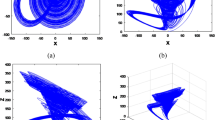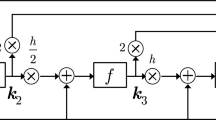Abstract
Parameter identification (PI) is very important in system analysis and controller design and has wide applications in industry. PI is an essential step in designing mathematical models of the dynamical systems based on the measured data. Identification of chaotic systems is very challenging due to the butterfly effect. Recently, a state-space-based cost function based on Gaussian mixture model (GMM) has been proposed for the PI of the chaotic systems. In there, a GMM as a statistical model of the measured data modeled static features of the chaotic attractors in the state space. In this paper, we propose a new method which incorporates static and dynamic features in the GMM modeling in order to achieve a better cost function for the PI problem. The proposed method can extract suitable information from the trajectory of the chaotic attractor. We conduct some experiments for one-dimensional PI. Using measured data from 4D and 3D chaotic systems, empirical results indicate success of the proposed method.










Similar content being viewed by others
References
K. Aho, D. Derryberry, T. Peterson, Model selection for ecologists: the worldviews of AIC and BIC. Ecology 95(3), 631–636 (2014)
C.M. Bishop, Pattern recognition. Mach. Learn. 128, 1–58 (2006)
F. Deng, J. Chen, C. Chen, Adaptive unscented Kalman filter for parameter and state estimation of nonlinear high-speed objects. J. Syst. Eng. Electron. 24(4), 655–665 (2013)
F. Ding, X. Wang, Hierarchical stochastic gradient algorithm and its performance analysis for a class of bilinear-in-parameter systems. Circuits Syst. Signal Process. 36(4), 1393–1405 (2017)
F. Ding, Y. Wang, J. Dai, Q. Li, Q. Chen, A recursive least squares parameter estimation algorithm for output nonlinear autoregressive systems using the input–output data filtering. J. Franklin Inst. 354(15), 6938–6955 (2017)
Q. He, L. Wang, B. Liu, Parameter estimation for chaotic systems by particle swarm optimization. Chaos Solitons Fractals 34(2), 654–661 (2007)
R.C. Hilborn, Chaos and Nonlinear Dynamics: An Introduction for Scientists and Engineers (Oxford University Press, Oxford, 2000)
A. Jafari, F. Almasganj, Using nonlinear modeling of reconstructed phase space and frequency domain analysis to improve automatic speech recognition performance. Int. J. Bifurc Chaos 22(03), 1250053 (2012)
S. Jafari, S.M.R. Hashemi Golpayegani, A. Daliri, Comment on ‘Parameters identification of chaotic systems by quantum-behaved particle swarm optimization’[Int. J. Comput. Math. 86 (12)(2009), pp. 2225–2235]. Int. J. Comput. Math. 90(5), 903–905 (2013)
S. Jafari, S.M.R. Hashemi Golpayegani, A.H. Jafari, S. Gharibzadeh, Some remarks on chaotic systems. Int. J. Gen. Syst. 41(3), 329–330 (2012)
S. Jafari, S.M.R. Hashemi Golpayegani, M. Rasoulzadeh Darabad, Comment on “Parameter identification and synchronization of fractional-order chaotic systems”[Commun Nonlinear Sci Numer Simulat 2012; 17: 305–16]. Commun. Nonlinear Sci. Numer. Simul. 18(3), 811–814 (2013)
M.T. Johnson, R.J. Povinelli, A.C. Lindgren, J. Ye, X. Liu, K.M. Indrebo, Time-domain isolated phoneme classification using reconstructed phase spaces. IEEE Trans. Speech Audio Process. 13(4), 458–466 (2005)
H. Kantz, T. Schreiber, Nonlinear Time Series Analysis, vol. 7 (Cambridge University Press, Cambridge, 2004)
J. Kennedy, Particle swarm optimization, in Encyclopedia of Machine Learning, ed. by C. Sammut, G.I. Webb (Springer, Boston, MA, 2011), pp. 760–766. https://doi.org/10.1007/978-0-387-30164-8_630
J. Kuha, AIC and BIC: Comparisons of assumptions and performance. Sociol. Methods Res. 33(2), 188–229 (2004)
S.-K. Lao, Y. Shekofteh, S. Jafari, J.C. Sprott, Cost function based on Gaussian mixture model for parameter estimation of a chaotic circuit with a hidden attractor. Int. J. Bifurc. Chaos 24(01), 1450010 (2014)
L. Li, Y. Yang, H. Peng, X. Wang, Parameters identification of chaotic systems via chaotic ant swarm. Chaos Solitons Fractals 28(5), 1204–1211 (2006)
M. Li, X. Liu, F. Ding, The gradient-based iterative estimation algorithms for bilinear systems with autoregressive noise. Circuits Syst. Signal Process. 36(11), 4541–4568 (2017)
S. Nakagawa, L. Wang, S. Ohtsuka, Speaker identification and verification by combining MFCC and phase information. IEEE Trans. Audio Speech Lang. Process. 20(4), 1085–1095 (2012)
Y. Shekofteh, F. Almasganj, A. Daliri, MLP-based isolated phoneme classification using likelihood features extracted from reconstructed phase space. Eng. Appl. Artif. Intell. 44, 1–9 (2015)
Y. Shekofteh, F. Almasganj, Feature extraction based on speech attractors in the reconstructed phase space for automatic speech recognition systems. ETRI J. 35(1), 100–108 (2013)
Y. Shekofteh, F. Almasganj, Using phase space based processing to extract proper features for ASR systems, in Telecommunications (IST), 2010 5th International Symposium on 2010. IEEE, pp. 596–599
Y. Shekofteh, S. Jafari, J.C. Sprott, S.M.R.H. Golpayegani, F. Almasganj, A gaussian mixture model based cost function for parameter estimation of chaotic biological systems. Commun. Nonlinear Sci. Numer. Simul. 20(2), 469–481 (2015)
Y. Tang, X. Guan, Parameter estimation for time-delay chaotic system by particle swarm optimization. Chaos Solitons Fractals 40(3), 1391–1398 (2009)
L. Wang, Y. Xu, An effective hybrid biogeography-based optimization algorithm for parameter estimation of chaotic systems. Expert Syst. Appl. 38(12), 15103–15109 (2011)
X. Wang, F. Ding, Joint estimation of states and parameters for an input nonlinear state-space system with colored noise using the filtering technique. Circuits Syst. Signal Process. 35(2), 481–500 (2016)
D.S. Weile, E. Michielssen, Genetic algorithm optimization applied to electromagnetics: a review. IEEE Trans. Antennas Propag. 45(3), 343–353 (1997)
G. Xu, Y. Shekofteh, A. Akgül, C. Li, S. Panahi, A new chaotic system with a self-excited attractor: entropy measurement, signal encryption, and parameter estimation. Entropy 20(2), 86 (2018)
L. Xu, F. Ding, Iterative parameter estimation for signal models based on measured data. Circuits Syst. Signal Process. 37(7), 3046–3069 (2018)
L. Xu, F. Ding, Recursive least squares and multi-innovation stochastic gradient parameter estimation methods for signal modeling. Circuits Syst. Signal Process. 36(4), 1735–1753 (2017)
L. Xu, W. Xiong, A. Alsaedi, T. Hayat, Hierarchical parameter estimation for the frequency response based on the dynamical window data. Int. J. Control Autom. Syst. 16(4), 1756–1764 (2018)
L. Xu, The parameter estimation algorithms based on the dynamical response measurement data. Adv. Mech. Eng. 9(11), 1687814017730003 (2017)
X. Yao, Y. Liu, Fast evolutionary programming, in Proceedings of the fifth annual conference on evolutionary programming (MIT Press, 1996), pp. 451–460
H. Zhang, B. Li, J. Zhang, Y. Qin, X. Feng, B. Liu, Parameter estimation of nonlinear chaotic system by improved TLBO strategy. Soft. Comput. 20(12), 4965–4980 (2016)
X. Zhang, F. Ding, F.E. Alsaadi, T. Hayat, Recursive parameter identification of the dynamical models for bilinear state space systems. Nonlinear Dyn. 89(4), 2415–2429 (2017)
Acknowledgements
The work described in this paper was supported by the research Grant from Shahid Beheshti University G.C. (SAAD-600-1076).
Author information
Authors and Affiliations
Corresponding author
Rights and permissions
About this article
Cite this article
Shekofteh, Y., Jafari, S., Rajagopal, K. et al. Parameter Identification of Chaotic Systems Using a Modified Cost Function Including Static and Dynamic Information of Attractors in the State Space. Circuits Syst Signal Process 38, 2039–2054 (2019). https://doi.org/10.1007/s00034-018-0967-5
Received:
Revised:
Accepted:
Published:
Issue Date:
DOI: https://doi.org/10.1007/s00034-018-0967-5




